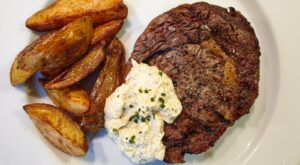Known for its intense bite, horseradish is a staple condiment in many cuisines. But for those unfamiliar with its potent flavor, the burning question remains – what does horseradish taste like? This article will break down horseradish’s flavor profile, culinary uses, health benefits and how to temper its heat.
Table of Contents
An Introduction to Horseradish
Horseradish is a root vegetable in the Brassicaceae family along with wasabi, mustard, and cabbage:
- Part of the same plant genus as wasabi but different species. Provides similar pungency.
- The large, white tapered root is harvested and grated to extract its robust flavor.
- Horseradish contains enzymes that generate heat when mixed with liquids. Vinegar stops this reaction.
- Native to Eastern Europe and Western Asia but now grown worldwide.
- Sold fresh in roots or prepared in jars and tubes, often mixed with vinegar and salt.
Now let’s explore the intense flavor that makes horseradish a legend.
What Does Horseradish Taste Like?
At first bite, horseradish delivers an explosive, searing heat throughout the nasal passages and throat along with an acidic bite. Specifically:
- Intense nasal heat similar to wasabi or hot mustard
- Blinding pungency that can make eyes water
- Brief slight sweetness giving way to acidic heat
- Lingering fiery sensation that fades slowly
- Subtle notes of mustard and garlic
- Tingling, buzzing mouthfeel similar to carbonation
- Difficult to detect any flavor besides spicy heat when raw
As part of the mustard family, horseradish packs an addictive punch that adds excitement to recipes when used properly.
How Horseradish Compares to Other Pungent Foods
Looking at how horseradish stacks up to other spices provides helpful context:
Wasabi
- Taste: Very similar nasal-clearing spiciness. Wasabi may be slightly more subtle.
- Smell: Wasabi’s aroma is greener and grassier.
- Use: Wasabi often used freshly grated; horseradish usually prepared.
Mustard
- Taste: Mustard has similar heat but more balanced, rounded flavor.
- Smell: Mustard gives off signature mustard aromas absent in horseradish.
- Use: Mustard can be used in larger quantities as condiment.
Ginger
- Taste: Ginger heat is more mellow, gradual; horseradish is explosive.
- Smell: Ginger is sweetly aromatic versus little smell of horseradish.
- Use: Ginger suits sweet applications better than sinus-clearing horseradish.
White Pepper
- Taste: White pepper brings more gradual, broad heat.
- Smell: Pepper is mildly aromatic versus horseradish’s pure pungency.
- Use: Pepper used as an overall seasoning; horseradish as a bold accent.
How to Cook With Horseradish
Using just a small amount of horseradish allows you to add a kick without overpowering:
- Sandwiches – A touch of prepared horseradish adds zing to roast beef, pastrami, and other sandwiches.
- Sauces and dips – Mix with mayo, sour cream or crème fraiche as a topper for beef, fish, and veggies.
- Dressings – Small amounts in vinaigrettes wake up greens, potatoes and slaw.
- Mashed potatoes – A tablespoon of prepared horseradish gives mashes a spicy lift.
- Bloody Mary – Horseradish and tomato juice were made for each other. Just don’t overdo it!
- Roasts – Grate fresh root over roasted beef or prime rib before serving.
Start with small amounts and add more heat gradually to suit your taste. Acid and fat balance horseradish’s heat.
What Foods Go Well with Horseradish?
Horseradish plays nicely with:
- Beef – roast beef, steak, burgers
- Seafood – smoked fish, salmon, oysters
- Potatoes – mashed, roasted, au gratin
- Dairy – cream, sour cream, cheese
- Vegetables – beets, carrots, turnips, cabbage
- Mustard – complementing flavors
- Vinegar – the acid balances the heat
- Horseradish truly invigorates and pairs well with rich, fatty ingredients.
Potential Health Benefits of Horseradish
Along with its robust flavor, horseradish may offer wellness advantages:
- Antibacterial, antifungal, and anti-inflammatory effects
- Possible cancer-fighting properties
- Contains beneficial enzymes like peroxidase
- Rich source of vitamin C, potassium, calcium, and magnesium
- Allyl isothiocyanate in horseradish may support metabolism
- Helps break down mucus and clear sinus congestion
In moderation, horseradish can form part of a healthy diet. But check with your doctor if you have gastrointestinal issues.
Key Takeaways on Horseradish’s Potent Taste
To recap, here are the key points on horseradish flavor:
- Horseradish tastes extremely pungent, like spicy nasal heat with an acidic kick. Even a small amount has bold impact.
- It is most similar to wasabi in its sinus-clearing strength but with more vinegar punch. A little horseradish goes a long way.
- Mix prepared horseradish into sauces, dressings, sandwiches and Bloody Marys. Pair with beef, seafood and vegetables.
- Horseradish contains healthy compounds and enzymes. But overconsumption may cause stomach upset in some people.
- With its sinus-blasting spice and ability to bring fun flare, horseradish deserves a spot in every flavor lover’s toolkit.
So if you enjoy exhilarating foods that make your palate tingle, don’t fear the horseradish – savor its power in moderation.

